Executive Education Program Market Insights 2025-2035
The executive education program market is projected to grow from in 2025 to by 2035, registering a CAGR of Growth is being led by demand for leadership transition tracks, strategic thinking modules, and data-centric decision frameworks tailored for senior executives.

| Metric | Value |
|---|---|
| Industry Value (2025) | |
| Forecast Value (2035) | |
| Global CAGR (2025 to 2035) |
Hybrid formats account for over of delivery, with asynchronous learning forming nearly a third of total instruction time. Face-to-face formats, which dropped to 14% during 2020 to 2021, have rebounded to over by 2024. Internal corporate academies are partnering with universities to deliver modular, credit-bearing programs aligned to enterprise KPIs.
Emeritus, and the Aresty Institute of Executive Education at the University of Pennsylvania's Wharton School announced the start of their six-month Emerging Chief Operating Officer (COO) Program in January 2025. The program's goal is to give prospective COOs the abilities they need to oversee intricate operational tasks, support strategic expansion, and handle changing organizational dynamics.
The cohort's enrollment period began on March 27, 2025. The curriculum covers topics including risk management, leadership communication, and data-driven decision-making, and it combines online learning with optional in-person networking (Wharton Executive Education, 2025).
Driven by leadership-focused programs, the market for executive education programs makes up an estimated of the corporate training industry. It accounts for around of the professional development market, mostly through C-suite preparedness modules. With a focus on non-degree and certificate offerings, it accounts for over of the higher education services industry. Driven by blended and virtual learning formats, it holds a market share in EdTech and online learning.
The market share for business consulting and advisory services is roughly , mostly due to strategic capability-building and leadership development workshops. The specialized but expanding significance of executive education across overlapping segments is reflected in these shares.
The industry will be primarily shaped by demand for customized programs, in-person learning, mid-level leadership development, and finance-focused courses. Programs lasting 1 week to 1 month will remain attractive for working professionals, while group learning formats will dominate delivery methods. Institutions are diversifying formats and curricula to align with corporate talent strategies across sectors such as finance, healthcare, and technology.
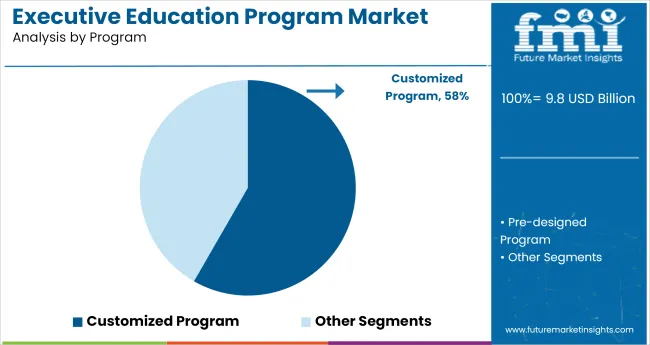
In 2025, customized programs are expected to make upof the market. Because these programs are created with particular organizational objectives in mind, businesses are able to match material with internal strategies, beliefs, and difficulties.
Because they provide flexibility in terms of distribution, location, and duration, they are appealing to businesses that oversee multinational teams. Because of their capacity to produce quantifiable results and their relevance to current business objectives, customized solutions are preferred.
Organizations like Harvard Business School and INSEAD have developed robust portfolios centered on customized programs that offer leadership development pathways that tackle challenging organizational transformations, strategy execution, and innovation cycles.
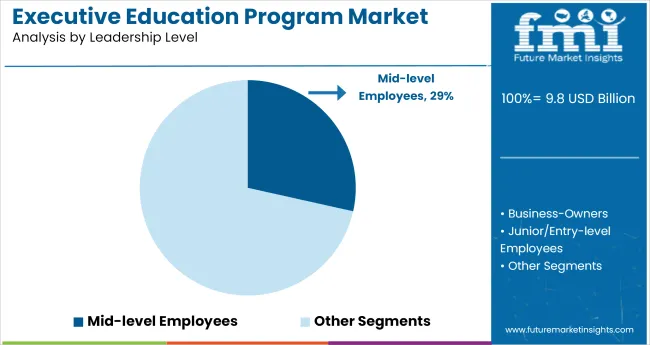
Mid-level employees are expected to hold a share in 2025. Programs that educate employees for more responsibility are receiving funding as businesses create succession pipelines. These programs emphasize critical skills like cross-functional cooperation, people leadership, and operational planning.
The development of mid-level professionals is a strategic objective since they are seen as essential linkages between executive vision and implementation. In order to help businesses close leadership gaps and provide internal development possibilities in competitive conditions, schools such as Wharton and London Business School are developing focused programs that bridge the move to senior jobs.
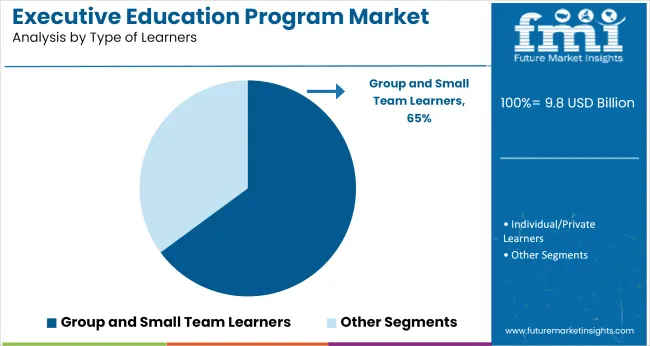
Group and small team learners are expected to contributeshare in 2025. Organizations are increasingly favoring cohort-based formats that foster collaboration, shared learning, and joint problem-solving. These models support peer-to-peer insight exchange and encourage application of new skills in live team contexts.
Corporate clients see value in synchronizing learning outcomes across teams to improve coordination and strategic alignment. Providers such as MIT Sloan and Stanford GSB are offering formats that involve business simulations, real-case consulting projects, and cross-functional challenge solving. The group learning model is preferred for its relevance to real workplace dynamics.
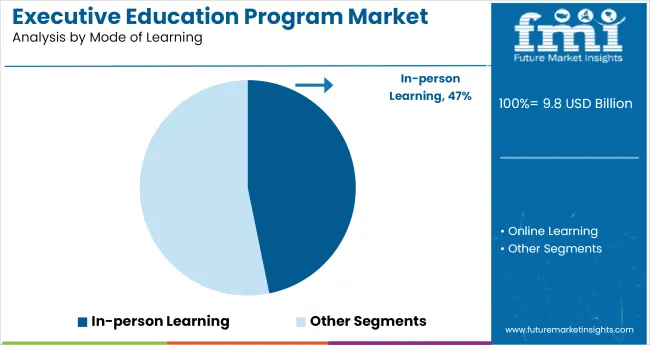
In-person learning is expected to account for share in 2025. This format remains popular for its immersive experience, direct faculty interaction, and opportunities for peer networking. Executives value the depth and engagement of face-to-face environments, particularly for leadership development, negotiation, and strategic thinking courses.
Institutions such as Columbia Business School and Kellogg School of Management continue to support in-person delivery with campus-based modules, real-time workshops, and leadership labs. While digital formats grow in parallel, in-person education continues to be prioritized for high-level participants seeking executive presence and cultural immersion.
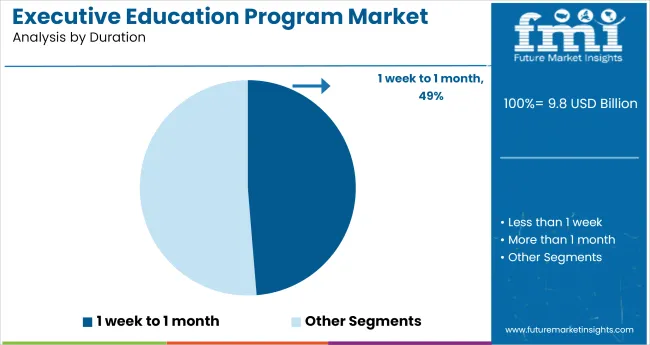
Programs lasting between 1 week and 1 month are projected to represent share in 2025. These short-duration formats appeal to professionals seeking to upgrade skills without extended work absences. Companies also prefer shorter commitments when scaling training across multiple teams or regions.
The format allows for concentrated learning with immediate application in work settings. Institutions like University of California, Berkeley and London Business School are increasing short-term offerings, covering topics such as digital transformation, strategy, and team leadership. These time-bound courses help professionals stay competitive while maintaining work continuity and cost efficiency.
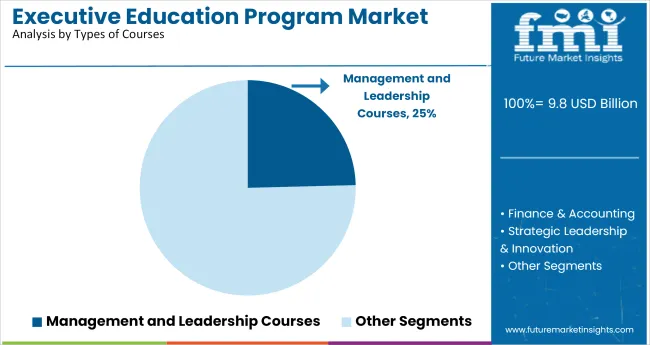
Management and leadership courses are forecast to hold share by 2025. These courses remain core offerings as businesses prioritize agility, decision-making, and organizational influence. Programs are structured to enhance executive communication, conflict resolution, and strategic vision, particularly for roles demanding cross-border or multi-team oversight. Business schools such as INSEAD and Harvard have structured their portfolios around these content pillars, delivering role-relevant leadership modules.
Professionals from fast-growing industries and transformation-driven sectors often prefer these courses for developing their leadership style and building executive presence, especially in environments marked by rapid technological and competitive shifts.
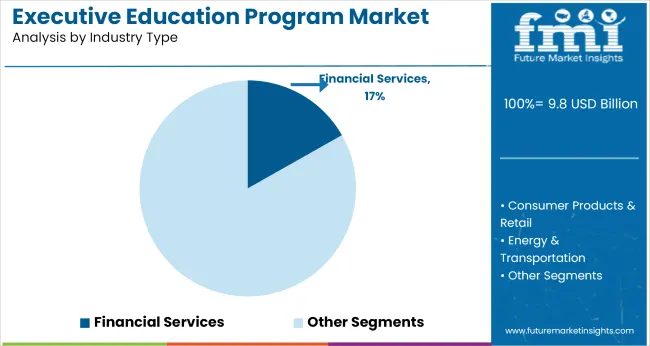
Financial services are expected to represent a share in 2025. The complexity of regulatory changes, fintech integration, and global risk management continues to reshape learning priorities within the sector. Financial institutions are investing in up skilling mid- and senior-level managers to address innovation-led disruption, operational compliance, and capital optimization.
Programs at Columbia Business School and University of Chicago Booth are being tailored for professionals in investment banking, asset management, and insurance. These institutions offer courses that focus on leadership in high-stakes financial environments, with content spanning valuation strategy, regulatory frameworks, digital assets, and financial decision-making.
The executive education program industry is driven by the rising demand for leadership development and skill enhancement across industries. Technological advancements, such as online and hybrid learning, are expanding accessibility. However, challenges such as high program costs, time constraints, and competition from alternative learning platforms impact industry growth.
The demand for executive education programs is driven by the increasing need for skilled leaders capable of adapting to dynamic conditions. Specialized training is sought by executives to enhance leadership and decision-making abilities. Technological advancements in online and hybrid learning formats are expanding the reach of these programs. Industries like finance, technology, and healthcare invest in customized education to ensure leaders possess the relevant skills to navigate rapid changes within their sectors.
High program costs present a major barrier to entry, especially for smaller companies and professionals with limited budgets. Time constraints also challenge professionals, as many are unwilling to commit to lengthy programs. The rise of alternative learning platforms like MOOCs and self-paced online courses provides affordable, flexible options, further intensifying competition. These challenges make it difficult for traditional executive education providers to maintain their dominance in the industry.
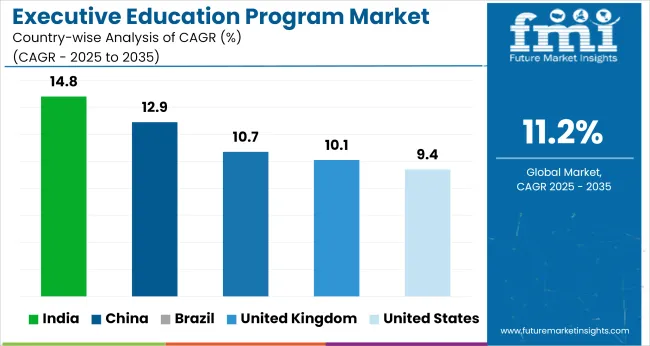
The report covers detailed analysis of 40+ countries, and the top five countries have been shared as a reference.
| Countries | CAGR (2025 to 2035) |
|---|---|
| United States | 9.4% |
| United Kingdom | 10.1% |
| China | 12.9% |
| India | 14.8% |
| Brazil | 10.7% |
The global executive education sector is projected to grow at CAGR from 2025 to 2035, with wide variation across economic blocs. India, a BRICS member, exceeds the global average by percentage points, reaching CAGR. This performance is driven by national skilling policies, digital cohort expansion, and institutional-private partnerships. China, also in BRICS, posts , with demand rising through enterprise-backed modular leadership programs and urban innovation hubs.
Brazil grows at just under the global average, with regional institutions integrating hybrid formats for mid-career professionals. OECD economies under perform the benchmark. The United States posts , slowed by declining corporate budgets for long-format courses and a shift to internal learning academies. The United Kingdom trails at, down points from the global trend, reflecting international student attrition and policy headwinds.
The executive education program market in the United States is projected to grow at a CAGR of from 2025 to 2035. This growth is driven by the increasing need for skilled leaders across various sectors, especially finance, technology, healthcare, and manufacturing. USA businesses are investing heavily in leadership development programs to equip executives with the tools necessary to navigate a rapidly evolving global landscape.
Institutions like Harvard Business School, Wharton, and Stanford Graduate School of Business continue to lead by offering tailored programs that cater to industry-specific needs.The demand for executive education is being further bolstered by the growing number of multinational corporations that require executives to adapt to shifting economic, technological, and regulatory environments.
The UK market is growing at a CAGR of from 2025 to 2035. This expansion is driven by the growing need for professionals in leadership and management roles to adapt to changing conditions and global business challenges. The UK is home to some of the world’s most prestigious business schools, such as London Business School and Oxford Saïd Business School, which continue to attract executives from across the globe.
As businesses in the UK face a range of complex challenges, including economic uncertainty, regulatory changes, and technological advancements, the demand for executive education is rising. These programs are increasingly seen as crucial for senior managers and executives to stay competitive and effective in leadership roles.
The executive education program in the China market is expected to experience a CAGR of from 2025 to 2035. The rapid economic growth and increasing presence in the industry have heightened the demand for executive education programs tailored to address specific challenges in leadership and business management.
Leading institutions like Tsinghua University and China Europe International Business School (CEIBS) are at the forefront of this market, offering programs designed to equip Chinese executives with the necessary skills to lead both domestic and international businesses. These programs focus on critical areas such as strategic management, digital transformation, and international business operations.
India’s executive education program market is projected to grow at a CAGR of from 2025 to 2035. This rapid growth is fueled by the country’s expanding corporate sector, which continues to embrace leadership training as a critical component of its business strategy. India’s fast-developing economy, along with a rising middle class, has spurred demand for skilled professionals, particularly in leadership roles.
Leading institutions like Indian School of Business (ISB), IIM Bangalore, and IIM Ahmedabad are capitalizing on this demand by offering tailored executive programs to equip professionals with advanced leadership and management skills. As more professionals seek to enhance their skills in a competitive job market, shorter-duration, more affordable courses are gaining traction.
The executive education program market in Brazil is expected to grow at a CAGR of from 2025 to 2035. This growth is driven by a need for advanced leadership development programs to guide organizations through economic uncertainty and market volatility. Brazil’s business environment is evolving, and companies are increasingly investing in executive education to ensure their leaders have the skills necessary to navigate these challenges.
Institutions such as FundaçãoGetúlio Vargas (FGV) and INSPER have established themselves as key players in this market, offering comprehensive programs that focus on leadership, strategic management, and innovation. As Brazil’s infrastructure development continues, there is growing demand for executive education that helps professionals adapt to rapid changes in the local and global business environments
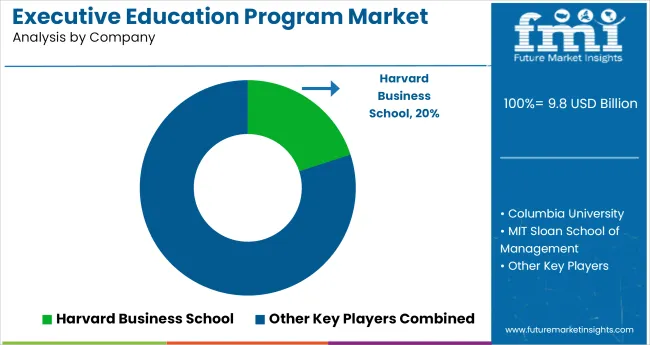
In the executive education program market, top institutions are scaling their influence through curriculum personalization, digital immersion, and corporate-aligned content delivery. Schools like Harvard Business School, MIT Sloan, and Stanford GSB are leading by integrating real-time business simulations, cross-border immersion modules, and industry-executive faculty into their offerings.
Programs from Wharton, Kellogg, and Columbia are using blended formats synchronous virtual sessions combined with short-campus intensives to increase accessibility while preserving peer interaction. Backend partnerships with edtech platforms allow schools such as UCLA Anderson, Ross, and Chicago Booth to expand modular learning, AI-driven assessments, and credential portability.
Baruch College, UBC Sauder, and Durham Business School are anchoring regional demand through lower-cost, high-impact programs tailored to mid-career professionals. Competition has grown as learners seek short-form, outcome-oriented education with global applicability. Leading players are advancing three priorities: credential stackability, industry co-certification, and enterprise partnerships allowing them to dominate a space increasingly shaped by professional agility, cost efficiency, and brand equity.
Recent Industry News
| Report Attributes | Details |
|---|---|
| Industry Size (2025) | USD 9.8 billion |
| Projected Industry Size (2035) | USD 28.3 billion |
| CAGR (2025 to 2035) | 11.2% |
| Base Year for Estimation | 2024 |
| Historical Period | 2020 to 2024 |
| Projections Period | 2025 to 2035 |
| Quantitative Units | USD billion for value and thousand enrollees for volume |
| Program Types Analyzed (Segment 1) | Customized Programs, Pre-designed Programs |
| Leadership Levels Analyzed (Segment 2) | Business-Owners, Junior/Entry-level Employees, Managers, Mid-level Employees, Senior Executives |
| Learner Types Analyzed (Segment 3) | Group/Small Team Learners, Individual/Private Learners |
| Modes of Learning Analyzed (Segment 4) | In-Person Learning, Online Learning |
| Course Durations Analyzed (Segment 5) | Less than 1 Week, 1 Week to 1 Month, More than 1 Month |
| Course Types Analyzed (Segment 6) | Management & Leadership, Finance & Accounting, Strategic Leadership & Innovation, Marketing & Sales, Business Operations & Entrepreneurship, Others |
| Industry Types Analyzed (Segment 7) | Consumer Products & Retail, Energy & Transportation, Financial Services, Healthcare & Pharmaceuticals, Manufacturing & Industrials, Professional Services, Technology & Communications, Others |
| Regions Covered | North America, Latin America, Europe, South Asia, East Asia, Oceania, Middle East & Africa |
| Countries Covered | United States, Canada, Brazil, Mexico, United Kingdom, Germany, France, India, China, Japan, South Korea, Australia, UAE, Saudi Arabia, South Africa |
| Key Players | Harvard Business School, Columbia University, MIT Sloan School of Management, Stanford Graduate School of Business, Baruch College, Wharton School of Business, UCLA Anderson School of Business, Kellogg School of Management, Stephen M. Ross School of Management, The University of Chicago Booth School of Business, The University of Texas at Austin, Cornell SC Johnson, Rotman School of Management, Ted Rogers School of Management, UBC Sauder School of Business, Durham University Business School |
| Additional Attributes | Dollar sales by course type and learning mode, rising demand from mid-level executives, increasing partnerships between universities and corporates, growth in modular and hybrid formats, regional enrollment and delivery format variations |
Key Segments
The segment is categorized into Customized Programs and Pre-designed Programs.
This includes Business-Owners, Junior/Entry-level Employees, Managers, Mid-level Employees, and Senior Executives.
The segment is divided into Group/Small Team Learners and Individual/Private Learners.
This includes In-Person Learning and Online Learning.
The segment covers Less than 1 Week, 1 Week to 1 Month, and More than 1 Month.
This includes Management & Leadership, Finance & Accounting, Strategic Leadership & Innovation, Marketing & Sales, Business Operations & Entrepreneurship, and Others.
The segment comprises Consumer Products & Retail, Energy & Transportation, Financial Services, Healthcare & Pharmaceuticals, Manufacturing & Industrials, Professional Services, Technology & Communications, and Others.
Regional analysis includes North America, Latin America, Europe, South Asia, East Asia, Oceania, and Middle East & Africa.
- Figure 138: East Asia Market Attractiveness Analysis by By Duration
- Figure 139: East Asia Market Value Share and BPS Analysis by Type of Courses, 2025 and 2035
- Figure 140: East Asia Market Y-o-Y Growth Comparison by Type of Courses, 2025-2035
- Figure 141: East Asia Market Attractiveness Analysis by Type of Courses
- Figure 142: East Asia Market Value Share and BPS Analysis by Industry Type, 2025 and 2035
- Figure 143: East Asia Market Y-o-Y Growth Comparison by Industry Type, 2025-2035
- Figure 144: East Asia Market Attractiveness Analysis by Industry Type
- Figure 145: South Asia & Pacific Market Value Share and BPS Analysis by Country, 2025 and 2035
- Figure 146: South Asia & Pacific Market Value Share and BPS Analysis by Program Type, 2025 and 2035
- Figure 147: South Asia & Pacific Market Y-o-Y Growth Comparison by Program Type, 2025-2035
- Figure 148: South Asia & Pacific Market Attractiveness Analysis by Program Type
- Figure 149: South Asia & Pacific Market Value Share and BPS Analysis by Leadership Level, 2025 and 2035
- Figure 150: South Asia & Pacific Market Y-o-Y Growth Comparison by Leadership Level, 2025-2035
- Figure 151: South Asia & Pacific Market Attractiveness Analysis by Leadership Level
- Figure 152: South Asia & Pacific Market Value Share and BPS Analysis by Type of Learner, 2025 and 2035
- Figure 153: South Asia & Pacific Market Y-o-Y Growth Comparison by Type of Learner, 2025-2035
- Figure 154: South Asia & Pacific Market Attractiveness Analysis by Type of Learner
- Figure 155: South Asia & Pacific Market Value Share and BPS Analysis by Mode of Learning, 2025 and 2035
- Figure 156: South Asia & Pacific Market Y-o-Y Growth Comparison by Mode of Learning, 2025-2035
- Figure 157: South Asia & Pacific Market Attractiveness Analysis by Mode of Learning
- Figure 158: South Asia & Pacific Market Value Share and BPS Analysis by By Duration, 2025 and 2035
- Figure 159: South Asia & Pacific Market Y-o-Y Growth Comparison by By Duration, 2025-2035
- Figure 160: South Asia & Pacific Market Attractiveness Analysis by By Duration
- Figure 161: South Asia & Pacific Market Value Share and BPS Analysis by Type of Courses, 2025 and 2035
- Figure 162: South Asia & Pacific Market Y-o-Y Growth Comparison by Type of Courses, 2025-2035
- Figure 163: South Asia & Pacific Market Attractiveness Analysis by Type of Courses
- Figure 164: South Asia & Pacific Market Value Share and BPS Analysis by Industry Type, 2025 and 2035
- Figure 165: South Asia & Pacific Market Y-o-Y Growth Comparison by Industry Type, 2025-2035
- Figure 166: South Asia & Pacific Market Attractiveness Analysis by Industry Type
- Figure 167: Middle East and Africa Market Value Share and BPS Analysis by Country, 2025 and 2035
- Figure 168: Middle East and Africa Market Value Share and BPS Analysis by Program Type, 2025 and 2035
- Figure 169: Middle East and Africa Market Y-o-Y Growth Comparison by Program Type, 2025-2035
- Figure 170: Middle East and Africa Market Attractiveness Analysis by Program Type
- Figure 171: Middle East and Africa Market Value Share and BPS Analysis by Leadership Level, 2025 and 2035
- Figure 172: Middle East and Africa Market Y-o-Y Growth Comparison by Leadership Level, 2025-2035
- Figure 173: Middle East and Africa Market Attractiveness Analysis by Leadership Level
- Figure 174: Middle East and Africa Market Value Share and BPS Analysis by Type of Learner, 2025 and 2035
- Figure 175: Middle East and Africa Market Y-o-Y Growth Comparison by Type of Learner, 2025-2035
- Figure 176: Middle East and Africa Market Attractiveness Analysis by Type of Learner
- Figure 177: Middle East and Africa Market Value Share and BPS Analysis by Mode of Learning, 2025 and 2035
- Figure 178: Middle East and Africa Market Y-o-Y Growth Comparison by Mode of Learning, 2025-2035
- Figure 179: Middle East and Africa Market Attractiveness Analysis by Mode of Learning
- Figure 180: Middle East and Africa Market Value Share and BPS Analysis by By Duration, 2025 and 2035
- Figure 181: Middle East and Africa Market Y-o-Y Growth Comparison by By Duration, 2025-2035
- Figure 182: Middle East and Africa Market Attractiveness Analysis by By Duration
- Figure 183: Middle East and Africa Market Value Share and BPS Analysis by Type of Courses, 2025 and 2035
- Figure 184: Middle East and Africa Market Y-o-Y Growth Comparison by Type of Courses, 2025-2035
- Figure 185: Middle East and Africa Market Attractiveness Analysis by Type of Courses
- Figure 186: Middle East and Africa Market Value Share and BPS Analysis by Industry Type, 2025 and 2035
- Figure 187: Middle East and Africa Market Y-o-Y Growth Comparison by Industry Type, 2025-2035
- Figure 188: Middle East and Africa Market Attractiveness Analysis by Industry Type
- Figure 189: Global Market - Tier Structure Analysis
- Figure 190: Global Market - Company Share Analysis
Frequently Asked Questions
What is the projected industry value of the executive education program market in 2025?
The industry is projected to reach USD 9.8 billion in 2025.
What is the expected global CAGR for the executive education program market from 2025 to 2035?
The industry is expected to grow at a CAGR of 11.2% from 2025 to 2035.
Which segment is expected to dominate the executive education program market in 2025?
Customized programs are expected to capture 58.3% of the market in 2025.
Which region is forecasted to show significant growth in the executive education program market by 2025?
South Asia, particularly India, is projected to register a CAGR of 14.8% from 2025 to 2035.
What is the forecasted industry value of the executive education program market by 2035?
The industry is projected to reach USD 28.3 billion by 2035.

Thank you!
You will receive an email from our Business Development Manager. Please be sure to check your SPAM/JUNK folder too.
You may also like...
Diddy's Legal Troubles & Racketeering Trial

Music mogul Sean 'Diddy' Combs was acquitted of sex trafficking and racketeering charges but convicted on transportation...
Thomas Partey Faces Rape & Sexual Assault Charges

Former Arsenal midfielder Thomas Partey has been formally charged with multiple counts of rape and sexual assault by UK ...
Nigeria Universities Changes Admission Policies

JAMB has clarified its admission policies, rectifying a student's status, reiterating the necessity of its Central Admis...
Ghana's Economic Reforms & Gold Sector Initiatives

Ghana is undertaking a comprehensive economic overhaul with President John Dramani Mahama's 24-Hour Economy and Accelera...
WAFCON 2024 African Women's Football Tournament

The 2024 Women's Africa Cup of Nations opened with thrilling matches, seeing Nigeria's Super Falcons secure a dominant 3...
Emergence & Dynamics of Nigeria's ADC Coalition

A new opposition coalition, led by the African Democratic Congress (ADC), is emerging to challenge President Bola Ahmed ...
Demise of Olubadan of Ibadanland
Oba Owolabi Olakulehin, the 43rd Olubadan of Ibadanland, has died at 90, concluding a life of distinguished service in t...
Death of Nigerian Goalkeeping Legend Peter Rufai

Nigerian football mourns the death of legendary Super Eagles goalkeeper Peter Rufai, who passed away at 61. Known as 'Do...

